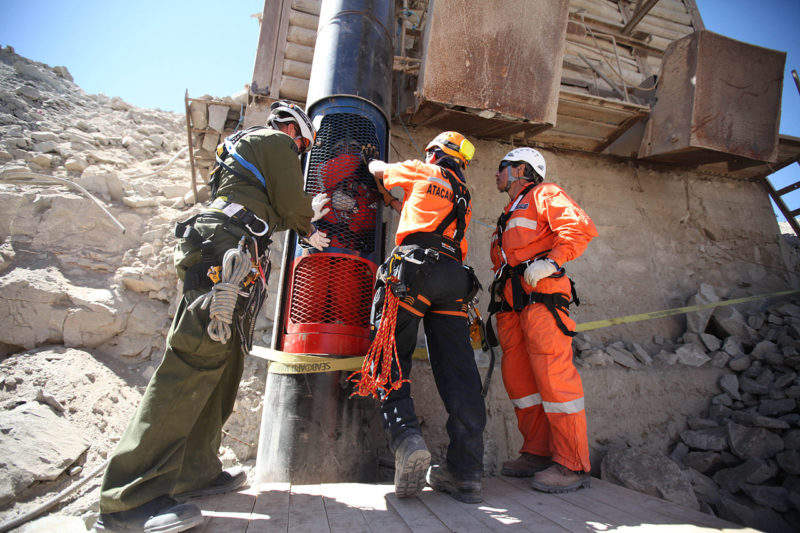
Rescuers were able to pump ten million gallons of water from the pond to free the driver, one of the latest acts of mine rescue heroics that has saved lives. Here are some of the most famous mine rescues.
How well do you really know your competitors?
Access the most comprehensive Company Profiles on the market, powered by GlobalData. Save hours of research. Gain competitive edge.

Thank you!
Your download email will arrive shortly
Not ready to buy yet? Download a free sample
We are confident about the unique quality of our Company Profiles. However, we want you to make the most beneficial decision for your business, so we offer a free sample that you can download by submitting the below form
By GlobalDataChile: August – October 2010
One of the most famous mine recues of recent years saw 33 miners extracted from the San José copper-gold project in northern Chile, following the collapse of the main entrance ramp that left workers stranded 700m below the surface. While the San Esteban-owned operation had a history of fatal accidents, with at least four deaths, all of the miners were successfully evacuated from the collapsed mine.
Rescue workers from Chile’s National Emergency office and navy submarine experts, alongside NASA engineers, used three drills to cut through 600m of rock to reach the miners. A hole, measuring 12 inches wide, was first drilled to the workers, before a wider hole was bored into the earth, large enough to fit an escape capsule. On 13 October, the final miner, foreman Luis Alberto Urzua Iribarren, was rescued from the mine, following almost 24 hours of rescue operations.
The miners were trapped underground for 69 days, and in the aftermath many were compensated for their ordeal; 14 received lifetime monthly pensions of $540. The rescue operation is estimated to have cost between $10m and $20m, but San Esteban agreed to sell the mine and use the proceeds to compensate the miners and pay government expenses.
China: March – April 2010
Just months before the rescue in Chile, China avoided its deadliest mining accident in two decades when over a hundred miners were rescued from the Wangjialing mine in Shanxi province.
The mine was still under construction when floods, possibly caused by water leaks in the mine’s foundations that went unrepaired as workers were pushed to finish the mine by October, trapped 153 miners underground on 28 March, as 108 fled to safety. The workers clipped themselves to the ceilings of the mine using their belts for three days, before rescuers installed pumps that drained more than 11 million gallons of water a day from the mine.
The miners alerted rescuers to their position by tapping on a pipe inserted into the mine to provide oxygen, and divers were sent in to recover the trapped miners, seven days after the accident. Unfortunately, they were unable to rescue all of the miners, and many were reported as missing as their bodies were never found, but 115 lives were saved. The mine has since passed a safety inspection by the Baode County Security Supervision Bureau.
Australia: April – May 2006
When a magnitude 2.1 earthquake hit the Beaconsfield gold mine in Tasmania, one of the 17 miners working underground at the time died. The majority, 14, were able to escape to the surface, leaving two miners trapped in a lift. The workers survived for one week on a single cereal bar and licking moisture from the rocks, before rescuers were able to give them food and water through a pipe drilled into the mine. They had to wait two weeks before rescue workers could reach them.
The emergency services blasted from the surface to the trapped miners, but had to abandon the first rescue tunnel as the miners would have to cut through the cage surrounding the lift to reach it, with both sides fearing that damaging the cage would cause the lift to collapse.
Rescue workers stopped blasting work and drilled a new tunnel between two existing passages, eventually excavating a tunnel beneath the trapped workers using a combination of drilling and blasting work.
The miners broke through the ground above the rescuers’ chamber at 4:27am on 9 May, and within an hour and a half both men had been evacuated to the surface. In the aftermath, the Australian Workers Union found that none of the Beaconsfield miners had been given workplace safety training, and that the mine was plagued by structural problems, including the removal of supports and the use of ineffective mesh to prevent rock falls.
United States: June – July 2002
A group of coal miners at the Black Wolf-owned Quecreek mine in Pennsylvania accidentally dug into the neighbouring Saxman coal mine on 22 June, which had not seen commercial production since 1963. Breaking into the abandoned mine flooded the Quecreek operation with 75 million gallons of water that had built up in the older mine. While half of the 18 workers were able to escape to the surface, the remaining nine were trapped in the mine’s shafts and chambers.
Rescue operations involved an experimental air pocket for the miners put forward by Mine Safety and Health Administration (MSHA) expert John Urosek, which successfully pumped oxygen into the chambers, as well as the use of diesel water pumps to remove 27,000 gallons of water per minute from the mine. Rescue workers eventually drilled a shaft from a farm belonging to local couple Bill and Lori Arnold to the trapped miners, and evacuated them individually, with the final miner reaching the surface at 2:45am on 28 July.
In the aftermath, one of the miners retired from the industry, while foreman Randall Fogle chose to remain in underground mining. The MSHA found that Black Wolf, which had been accused of 25 safety violations prior to the accident, had not supplied an up-to-date map of the Quecreek or Saxman mines to the workers or the state.
United States: October 1987
In October 1987, an 18-month-old girl was rescued from a well shaft in Midland, Texas, after spending two and a half days 6.7m underground. Jessica McClure was believed to have removed a flower pot covering a crack in the ground that lead to the abandoned shaft while playing in her aunt’s garden, before falling into the shaft and landing in a chamber around 12 inches wide.
Emergency workers were able to reach her before she suffered any significant injuries. They drilled a shaft from the surface running parallel to the well shaft, and a smaller horizontal tunnel to reach McClure, where they placed a speaker to allow her mother to communicate with her. Rescuers were then able to cover her with petroleum jelly, strap her to a board and pull her up through the parallel shaft to the surface. She was immediately taken to hospital and found to have suffered no internal injuries or broken bones, although a toe was amputated after she contracted gangrene.
Today, McClure still lives in Midland, and is married with two children.




